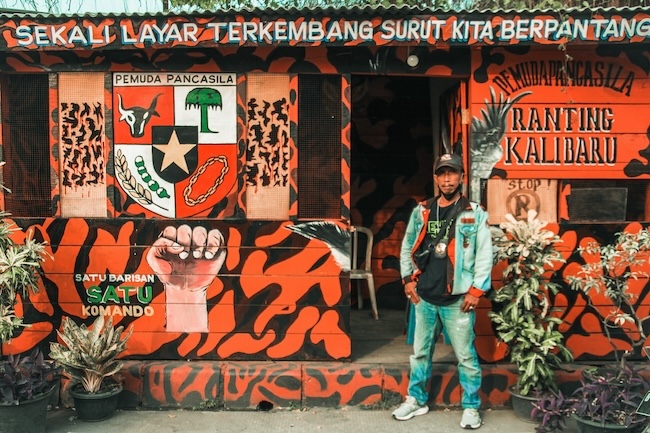Andy Fuller & Zaki Arrobi
This edition of Inside Indonesia has grown out of a related research project at Utrecht University titled 'Sacralising Security: Religion, Violence and Megacities of the Global South (SACRASEC). The focus of the project, led by Prof. Martijn Oosterbaan, is on understanding the ways religious actors and organisations are increasingly involved in securitising practices in urban environments, such as Jakarta. In this edition of Inside Indonesia, while touching on security issues, our contributors also extend their analysis to adjacent themes related to contemporary Islamic practice and identity politics.
Part of the aim of this brief snapshot of articles on urban Islam and security is to highlight the multiple ways in which Islam is articulated and drawn upon as well as how its political symbolism is of particularly strong currency in the post-Reformasi era. We believe that in the lead up to the 2024 elections the contested nature of what Islam is and means, will continue to be increasingly important.
The edition
In Andy Fuller’s interview with Dr Sana Jaffrey of the ANU, she shares her experience of researching vigilantism in post-New Order Indonesia. One of her findings is that the rise in vigilantism is not due to the absence of the State, but that it has gone hand in hand with the increase in police numbers and funding. The police have not necessarily protected those who have been accused of blasphemy, but instead coerced victims into signing statements in which they formally apologise to religious-vigilante leaders such as Rizieq Shihab of the now-disbanded FPI.
Reflecting on his fieldwork on the everyday life of kampung residents in an inner-city district of Jakarta, in his piece on Habib Rizieq (aka Rizieq Shihab) Arrobi argues that the cleric has become an ‘anti-establishment’, ‘revolutionary’ personage, as well as an ‘Islamic saint’-like figure for some urban Betawi residents and youth. Arrobi concludes that this growing infatuation with such a charismatic figure speaks to a broad feeling of marginalisation and insecurity, rather than solely an indication of religious conservatism.
Rizieq, however, is not the only face of ‘Islamic populist’ preacher with the potential to mobilise grievances among those people living along Jakarta's margins. In their article, Akmaliah and Pamungkas discuss how Bahar bin Smith has gained ascendancy among the supporters of ‘212’ Movement in Jakarta. They predict that such a figure could potentially play important roles in the context of increasingly precarious urban life and contentious electoral battle ahead of the Presidential election in 2024.
The ‘urban precariat’ in Jakarta is often involved in ethnic and religious vigilante groups as a way to secure access to employment and participate in community life. Drawing on his fieldwork in post-pandemic Jakarta, Andy Fuller writes of the efforts of the Forum Betawi Rempug (Betawi Brotherhood Forum, FBR) to ‘reclaim’ Jakarta for the ‘indigenous’ people of this megacity of the Global South. The FBR combines a vigilante urban security presence while articulating a Betawi identity, which emphasises Islamic religiosity, distributing charity as well providing informal work opportunities for (apparently) reformed preman. The FBR positions itself as an organisation which collaborates with both the government and society to meet the needs of both.
Jakarta’s religious landscape is of course more diverse than just a site for religious vigilantism. The city has always been a place of contested sites in which various religious groups thrive. In his article, Aidulsyah suggests that Salafism has successfully redefined its public image among the urbanites, from a conservative and exclusivist religious group to a pop culture da’wa movement. Thanks to their ability to combine elements of popular culture through savvy social media, Salafi study groups (majelis ta’lim) have attracted both lower-class workers in the mosques in busy business districts like Blok M and Pasar Senen, and upper-middle class residents at Al-Azhar Mosque in South Jakarta.
Lastly, in his photographic essay, Ahmad Tri Hawaari’s images highlight the long-standing urban form of the gardu or security post that can be found throughout many Indonesian cities. These watch houses are community-based spaces which are often times adorned with the branding of societal-organisations (organisasi masyarakat; ormas). Hawaari’s images mainly depict the ubiquitous gardus of the FBR found throughout Jakarta.
We would like to thank the team at Inside Indonesia for working on this edition with us. We would also like to thank all the contributors: Sana Jaffrey, Fachri Aidulsyah, Cahyo Pamungkas & Wahyudi Akmaliah and Ahmad Tri Hawaari.
Andy Fuller is a postdoctoral research fellow at Utrecht University and founder of Reading Sideways Press. Zaki Arrobi is a PhD researcher at the Department of Cultural Anthropology, Utrecht University, the Netherlands, and a lecturer at the Department of Sociology, Gadjah Mada University, Indonesia.












